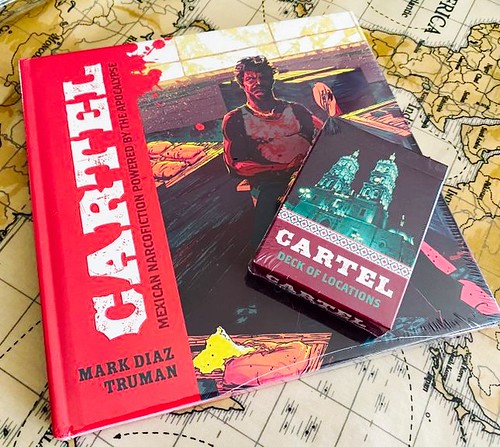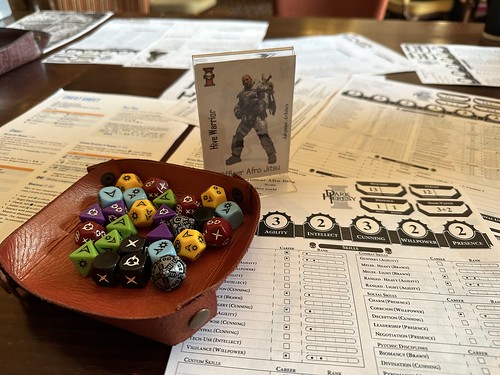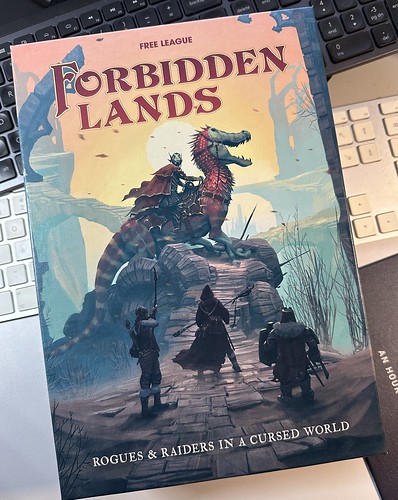 |
The Cartel RPG and supporting cards
|
This is a review I really didn't expect to write.
TL;DR: Cartel is one of the most sharply written Powered by the Apocalypse roleplaying games I've seen; there's nothing wasted and the game is constructed to make players spark off each other and feel like they're caught up in the drugs war. The book is beautifully put together and illustrated. If your gaming table isn't afraid of some character-vs-character conflict, then this is definitely worth checking out.
I first came across Cartel at the Revelation convention, where it was an early release ashcan. I'm not certain if the game had actually been through Kickstarter at that point, but if it hadn't then it would be imminent. We ended up with a small group of players, all ready to try something different, and we had one of the best games that I've ever played. It was plotting, scheming, twists and you were as likely to get stabbed in the front as in the face. There's very much a player-vs-player aspect to this, but actually, it's really character-vs-character. You're looking to generate situations and friction as your characters, all tied to the drug cartels in some way (even if only the spouse of someone who is involved) try to get by in their day-to-day without getting fucking shot. It's brutal, tense and has highs and lows. At the end of the game we played, it felt like we'd just participated in the pilot to a TV series. Kudos to Nigel, our MC, and the other players.
I'm not going to apologise for the profanity before, because that's the name of the one move you don't want to have to make in the game. Getting Fucking Shot is the one move that can take your character out of the game, and it's brutal. The more heat the group around you is facing, the nastier the situation and the higher the likelihood you will die, maybe not immediately, but soon after. This is not a nice game. This is a game that puts your characters front and centre in the drug war and friction between different cartels in Durango in Mexico. If you can handle that, you're likely to have a fantastic game.
Cartel is strikingly presented. It's a 160-page hardcover, printed in a square format in bright and shiny colour - red, pink, green, yellow. It has great artwork, and I didn't see a typo throughout the game. It has a pink ribbon.
Cartel was also originally due to be delivered in February 2019. It reached retail in the UK in December 2020, and backers in the UK didn't get their copies until April 2021 due to a shipping error by Magpie Games. As I write this, it has been 16 months since the last update on the Kickstarter, although the author posted a comment on New Year's Eve (31 December 2023) promising an update in January. Magpie have taken payment for PDFs and two extra books from some backers, and they've not delivered. Universally, I've found that lack of information, poor information and outright misinformation are how Magpie behave on kickstarters; I've seen the same with the Urban Shadows 2e kickstarter. I will never back one of their kickstarters again.
Yet, Cartel is absolutely brilliantly done. Tautly written. Packed with advice. Sharply focused. Mark Diaz Truman really gets Powered by the Apocalypse (PbtA). Every product I have seen from Magpie is similar; well-written, focused and a great experience. There is absolutely no reason not to pick up this game from retail. In fact, I recommend you do, if the idea of exploring the drug war in a tense conflicted game appeals to you.
The engine is a tuned evolution of the PbtA core. Each character has four stats: Face, Grit, Hustle and Savagery which provide modifiers to a 2d6 roll where you're looking for 7+ (partial success), or 10+ (for complete success). Each player has a unique character playbook. These could the El Cocinero (responsible for drug production), La Esposa (the tie to family), El Halcón (young, naive and wanting to make their way in the cartel), El Narco (the boss), La Polizeta (a corrupt police officer), La Rata (a mole for law enforcement) or La Sicaria (the professional killer). There are actually some additional playbooks that have been shared beyond these, but they're from the expansion material on the CIA and beyond.
Each playbook has some custom moves, and then three Llaves (keys) to choose two from. They're tailored to the playbook; if you act in line with them, you mark experience. The playbooks include advice on how to play the character and examples of fictional characters to draw upon. Characters get to build relationships with all the other players; these provide the impetus for much of the story; the MC will use these Enlaces as levers if the players don't. Ideally everyone will draw on these to inspire action. There's solid guidance on how to construct a relationship map, something that should be at the heart of a game.
Heat is tracked, marking the attention that law enforcement is giving your character. In a scene, the character with the highest heat will drive the reaction.
Lifestyle is also set, and drives what cash or assets that you have available. If you can't get the money, you may need to hustle or steal, especially if you can't strain your finances enough.
Stress is tracked; it's at the heart of the game. If you fill the track it limits how your character can respond; they're vulnerable to pressure and struggle to justify their behaviours. The only way to lose stress is to take a specific move to do so, all of which will cause a mess. Verbally abuse or shame someone, dish out a beatdown, confess your sins or lose yourself in a substance to recover; but be aware that there are consequences. You always begin a session with two of your five stress track boxes filled, so it's easy for things to escalate and for your character to become overwhelmed.
Cartel's agendas are pretty focused:
- Make the drug war seem real.
- Keep the player character's lives exciting
- Play to find out what happens
The principles are also strong (comments like this mine):
- Ground the story in Durango, Mexico
- Speak to the characters, not the players
- Make your move, but never speak its name
- Name everyone, give them drives and instincts (ie NPCs)
- Treat everyone as expendable and suspicious
- Fill the character's lives with secrets
- Make the authorities a persistent presence
- Be a fan of the PCs and their schemes
- Embrace the language of la guerra antidrogas (violence)
- Sometimes, declaim decision making (and let the dice decide)
The game makes less distinction of which MC moves are hard or soft (and explains that you can choose how this plays out). Moves include:
- Escalate a situation to violence
- Shoot someone
- Threaten someone's interests
- Disrupt someone's routine
- Offer a difficult compromise
- Turn their move back on them
- Lean on a secret
- Demand someone play their part
Although there's some overlap with other PbtA games, these are all very pointed and focused on escalating and pressuring the situation.
The book has a good introductory section on the drugs war, combined with a strong section for the MC on how to run the game, which has an extended example. Throughout, there are sidebars which link actual events to the text described.
The book wraps with a decent index.
There is a map of Durango available separately (not sure if it comes as part of the PDF package if you get this retail) and also some really good location cards with specific moves for each. I'd recommend these if you can get hold of them.
Originally, I thought I'd never write this. I've quite often flipped and sold on delayed or poorly communicated kickstarters, but having played Cartel, I didn't want to sell this on. I knew I'd really enjoyed it. What gave the the impetus to read it was a decision to potentially run this at Revelation in February 2024. I figured that if I did that, then it would make me read it and make a decision about whether I keep the book. Having read it, I definitely want this in my library, and I'm going to run it.
In conclusion, Cartel is one of the most sharply written Powered by the Apocalypse roleplaying games I've seen; there's nothing wasted and the game is constructed to make players spark off each other and feel like they're caught up in the drugs war. The book is beautifully put together and illustrated. If your gaming table isn't afraid of some character-vs-character conflict, then this is definitely worth checking out.
But I'm still conflicted over Magpie Games and won't back another Kickstarter from them.
6 January 2024













